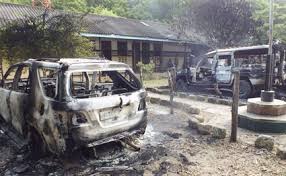Is Al-shabaab planning to determine who wins in Kenya 2017?
There is a surge in
the frequency and intensity of terror attacks on Kenyan Soil. In an- 8 – week
period up to Mid-July, there were 15
terror incidents in Northern Kenya towns and Lamu county at the coast, a majority of which involved blasts caused by
IEDs.
 |
| The Mangled wreckage of an APC hit by Al-shabaab AIED |
The 15 incidents cost 55 lives a majority of them Security
agents. Forty security agents including Policemen and Soldiers. The rest were
civilians including four school children, nine adults beheaded and a relative of
a Permanent Secretary who was killed as the terrorists abducted the PS. She was
later rescued by the security forces.
Out of the 15 incidents, thirteen involved IED blasts targeting
the security agents. The death toll from the incidents is also a sharp 690
percent rise from the situation in January to April when one death or none at
all were recorded per incident. The current spate of attack averages 7 deaths
per week.
All security officers were killed by IEDs. This is a
worrying trend for targeting security agents destroys their vehicles thus slowing
down police response time. It also instills fear on the officers, again slowing
down their response time.
 |
| Aftermath of Mpeketoni attack in 2016 |
The 1500 Percent surge in terror activity coincided with the
beginning of the Muslim holy month of Ramadhan during which terror activity
increases. However, MEARisk warns that this could this be a precursor to bigger
attacks. The slaughter of nine villagers
on July 8th, the first of its kind on Kenyan soil, but a common
occurrence in Somalia, marked the acceleration of militant cruelty to a new
high.
The report says that in April, the Kenya Defense Forces
operating under AMISOM in Somalia killed 76 Al-shabaab operatives in Gedo
region of Somalia. Before then, in March KDF had killed another 57 militants.
Other attacks have also been reported in the Somali media where KDF has killed
tens of militants.
So the killing of the 40 officers could easily be dismissed
as revenge for Kenyan killings of Al- shabaab militants.
However, there is more to it than just revenge. It will be
recalled than in 2013, Al- shabaab militants struck at Nairobi’s Westgate Mall
killing 62 people. In 2015, Al-shabaab struck again, killing 148 students of
the Garissa university college.
In June 2014, Al- shabaab
struck in Mpeketoni in Lamu County, killing 100 people. In between 28 bus passengers, most of them
teachers and nurses were killed in al-Shabaab attacks in Wajir. Quarry workers
were also targeted.
In February 2016, Al-
shabaab attacked a Kenyan military base in El- Adde Somalia, killing an
estimated 180 soldiers.
These events may appear unrelated, except that they had one
common thread, they were designed to disillusion Kenyans at home to force them
to demand the withdrawal of Kenyan forces from Somalia. The government, for its part, has been firm
that they will not be withdrawn.
If the earlier attacks had a political agenda, then they
failed because Kenyan troops are still in Somalia thumping Al-shabaab at will.
The surge in terror activity so close to the elections in
August 2017 could be a pointer to a political agenda. It could signal Al-
shabaab’s desire to influence the forth coming elections in Kenya slated for
August 8th, 2017. It could determine the winner!
In 2014, Al-shabaab
hit Mpeketoni just a day before the launch of the” Infamous US$2 billion”
sovereign bond. Analysts then saw the attack as an attempt to sabotage the bond.
That attempt failed as the bond was oversubscribed by 400 per cent.
Can similar attacks
be shrugged off this time around? This is an election year and Al-shabaab could
be working to demoralize voters or to incite them to change the regime.
Terrorists are known to influence an election through a surge in terror
activities, says the MEARisk report.
Unlike 2013 and 2014, the security forces in Kenya have
gained a lot of knowledge about the terror group. They have learnt to work
jointly- sharing information and experiences.
This is one of the reasons Nairobi has become safe from Al- shabaab
threat. However, this being an election year, Al- shabaab could try to be more
cruel and daring.
Perhaps attacking a
crowded campaign rally in Kenya. Terror groups always do that. For instance,
early in this decade, the Spanish rebel group, ETA, bombed a Railway station
just a day before an election. The incumbent Prime Minister lost the election.
If a crowded political
rally is hit so close to the election, Voters would blame the government for
failure to protect them, warns the report, and vote it out.



Comments
Post a Comment